10 Candidate Experience Best Practices for 2025
In today's competitive job market, a negative hiring experience can cost you more than just a great candidate—it can actively damage your brand reputation. Top professionals now expect a seamless, respectful, and transparent journey from their initial application to a final offer. Neglecting this crucial aspect of recruitment means consistently losing your most sought-after candidates to competitors who have refined their approach. A poor process not only deters immediate applicants but also creates negative word-of-mouth that can impact future talent pools.
This guide moves beyond generic advice to provide 10 essential candidate experience best practices, grounded in research and proven by industry leaders. By implementing these actionable strategies, you can transform your recruitment process into a powerful magnet for attracting and retaining the best talent. The goal is to ensure every applicant, whether hired or not, becomes an advocate for your brand. To truly prevent losing top talent, it's essential to understand the principles behind an efficient hiring process. For a complete guide on this, explore how to start mastering your efficient hiring process to build a solid foundation. Let's dive into the specific steps you can take to create a positive and memorable journey for every candidate.
1. Clear and Transparent Communication
One of the most impactful candidate experience best practices involves establishing and maintaining clear, consistent, and honest communication from the first touchpoint to the final decision. This means proactively managing candidate expectations about timelines, next steps, and the decision-making process. A lack of communication is a primary source of candidate frustration, leading to a negative perception of your employer brand, regardless of the hiring outcome.
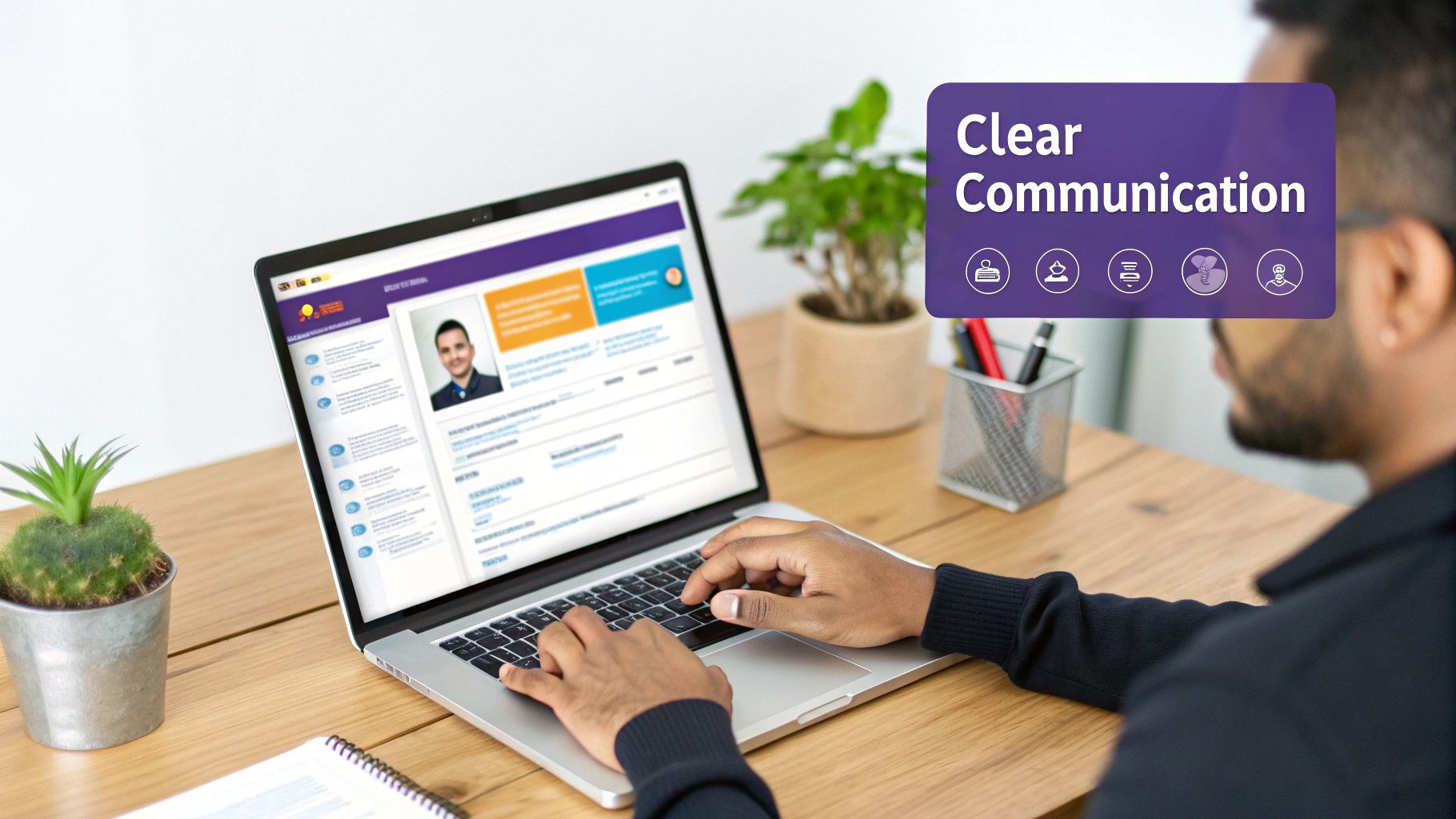
When candidates are left in the dark, they often assume the worst, disengage from the process, or accept other offers. Transparent communication builds trust and respect, showing applicants you value their time and effort. Companies like Salesforce excel at this by providing clear hiring timeline expectations on their career pages, while Buffer famously documents its entire hiring process publicly. This level of openness demystifies the process and empowers candidates with the information they need.
How to Implement Transparent Communication
- Automate Initial Contact: Set up an automated yet personalized email to confirm receipt of every application. This simple step assures candidates their submission was successful.
- Provide a Clear Timeline: In the initial confirmation or first human interaction, provide a realistic timeline. For example: "Our team will review applications over the next week, and you can expect to hear from us regarding next steps within 10 business days."
- Communicate Delays: If your timeline shifts, send a brief update. A simple message like, "We've had a high volume of applicants and our review is taking longer than expected. We appreciate your patience and will be in touch soon," can prevent candidate anxiety.
- Offer Constructive Feedback: When possible, provide brief, constructive feedback to rejected candidates, especially those who reached later interview stages. This demonstrates respect and helps them in their job search, leaving a lasting positive impression.
2. Streamlined Application Process
Another critical component of candidate experience best practices is creating a simple, intuitive, and quick application process. A complicated or lengthy application is a major deterrent, causing top talent to abandon the process before they even finish. The goal is to minimize friction and respect the candidate’s time by making it as easy as possible to express interest in a role. This initial interaction sets the tone for the entire hiring journey.
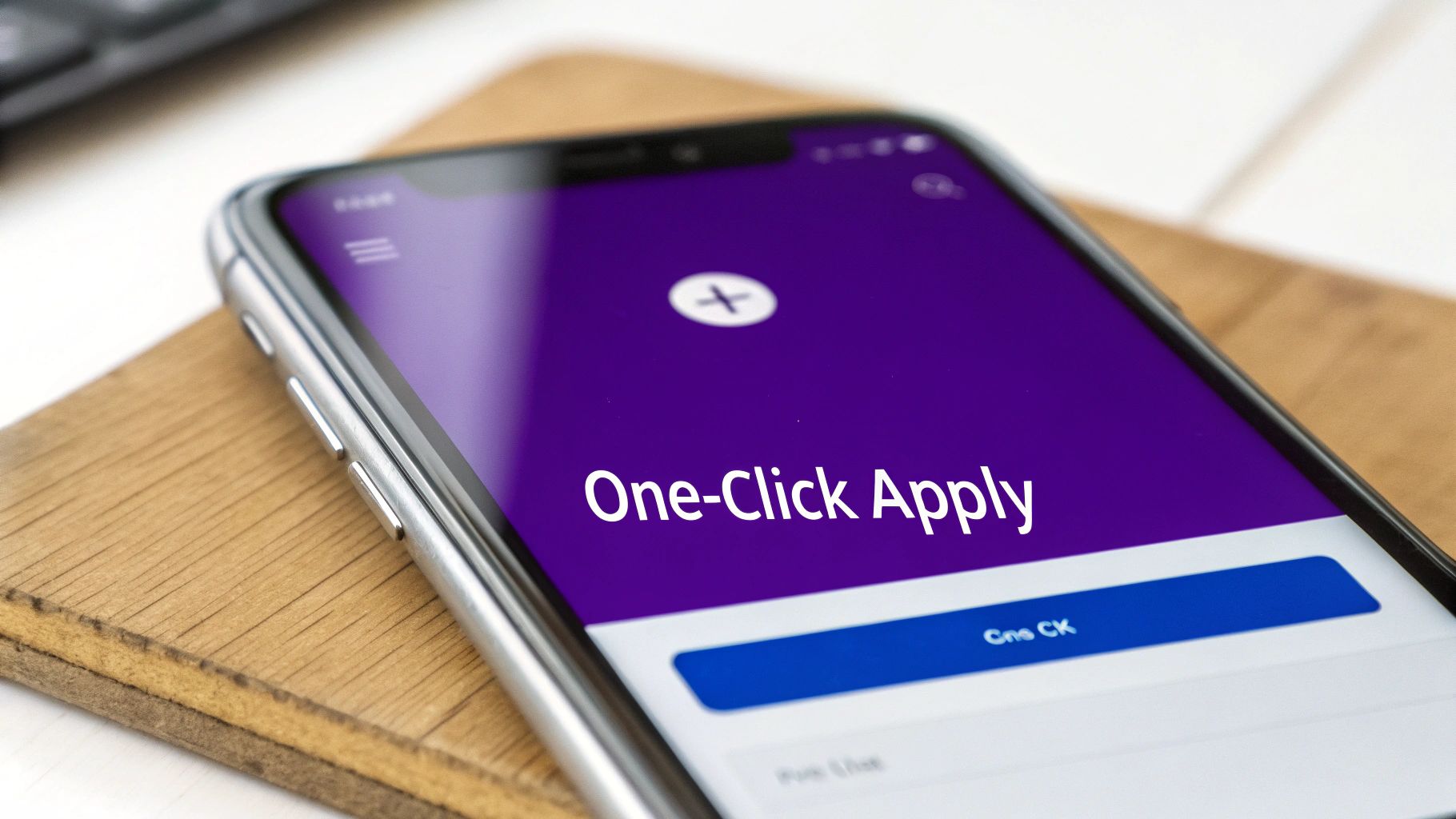
When an application takes 30 minutes and requires re-entering information already on a resume, candidates rightly feel their time is not valued. This friction can lead to a significant drop-off rate, especially among passive candidates or those applying from mobile devices. Companies like Unilever have addressed this by implementing one-minute mobile applications, while features like LinkedIn's quick apply have become standard expectations. A seamless system shows that your organization is modern, efficient, and considerate of its applicants.
How to Implement a Streamlined Application Process
- Audit and Simplify Your Forms: Review every field in your application and ask if it's absolutely necessary at this stage. Eliminate redundant questions and anything that can be asked later in the process.
- Enable Profile Imports: Allow candidates to auto-fill their applications by importing data from their LinkedIn or Indeed profiles. This significantly reduces manual data entry and speeds up completion.
- Prioritize Mobile Optimization: Ensure your application is fully functional and easy to navigate on a smartphone. A huge portion of job seekers browse for roles on their phones, and a poor mobile experience is an immediate turn-off.
- Allow Progress Saving: Give candidates the option to save their application and return to it later. This simple feature accommodates busy schedules and prevents the frustration of losing progress. Streamlining these steps is a key part of effective job application tracking.
3. Personalized Candidate Experience
Moving beyond generic, one-size-fits-all communication is one of the most effective candidate experience best practices for making applicants feel valued. Personalization involves tailoring interactions, content, and the overall journey to an individual's background, the specific role they applied for, and their experience level. This approach demonstrates a genuine interest in the candidate as a person, not just as an application number, creating a more memorable and engaging process.
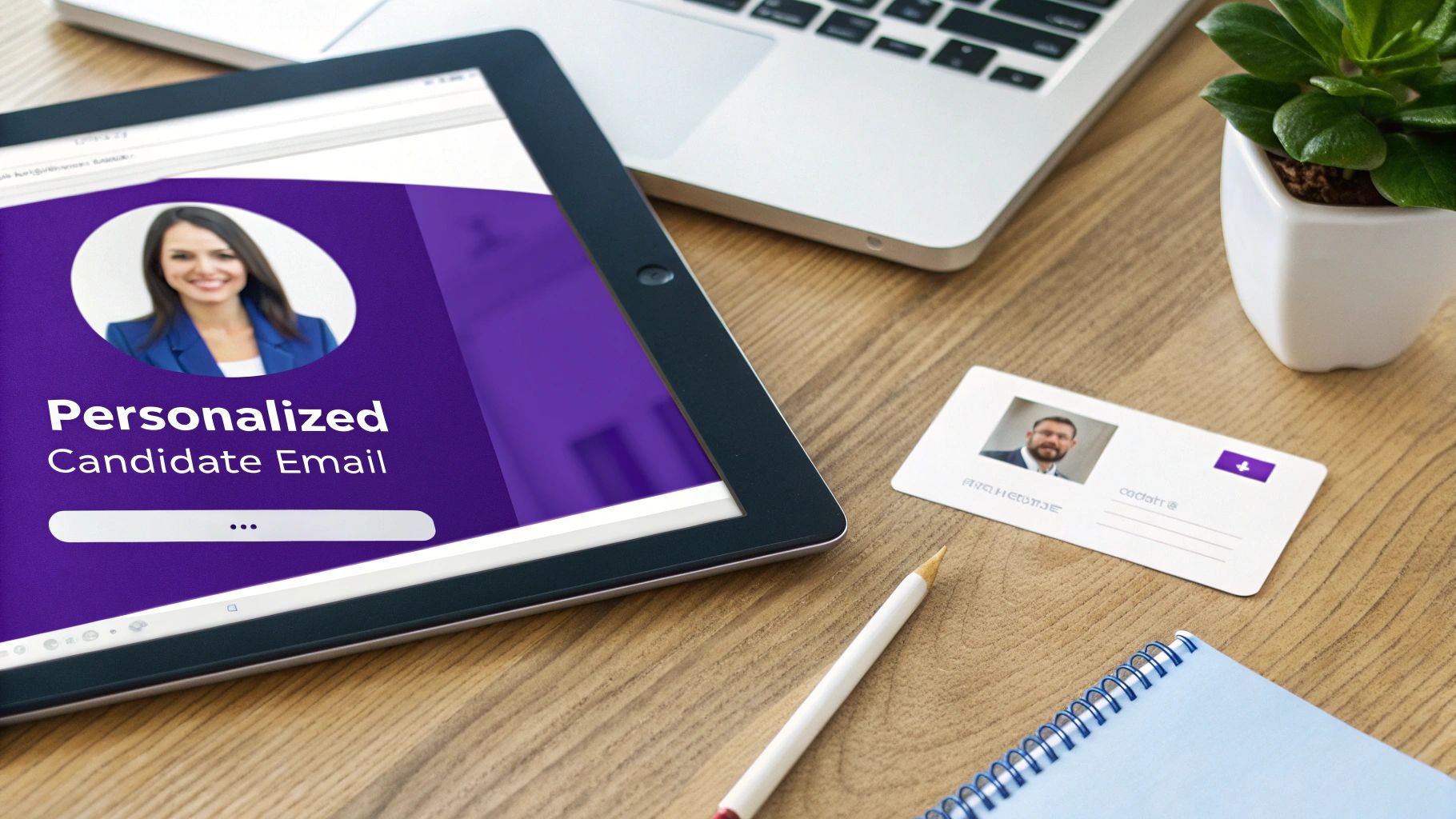
When candidates receive content and communications that are directly relevant to them, it builds a stronger connection to your company. For instance, Google provides customized interview prep materials based on the role, while McKinsey designs distinct recruitment journeys for different candidate profiles. Achieving a truly unique and engaging journey for each applicant is now more feasible than ever; a great way to start is by implementing personalized candidate experiences at scale with Generative AI. This level of detail shows you've done your homework and respect the candidate's unique qualifications.
How to Implement a Personalized Experience
- Segment Communications: Group candidates by role type (e.g., engineering, marketing) or experience level (e.g., entry-level, senior) and customize your email templates and updates for each segment.
- Share Role-Specific Resources: Send candidates relevant content like a blog post written by a team member they might work with, details about a project specific to their function, or insights into the team's culture.
- Customize Interview Questions: Go beyond a standard question list. Ask questions that directly relate to a specific project or skill mentioned on the candidate's resume to show you've paid close attention.
- Use Their Name and Role: Always address candidates by name and mention the specific role they are interviewing for in all communications. This simple step avoids the impression of a mass, impersonal process.
4. Timely Interview Scheduling and Flexibility
Another crucial component of candidate experience best practices is streamlining the interview scheduling process to be fast, easy, and accommodating. Excessive back-and-forth emails to find a suitable time can frustrate candidates, who are often juggling their current job, personal commitments, and interviews with other companies. A frictionless scheduling experience shows that you respect the candidate's time and are an efficient, modern organization.
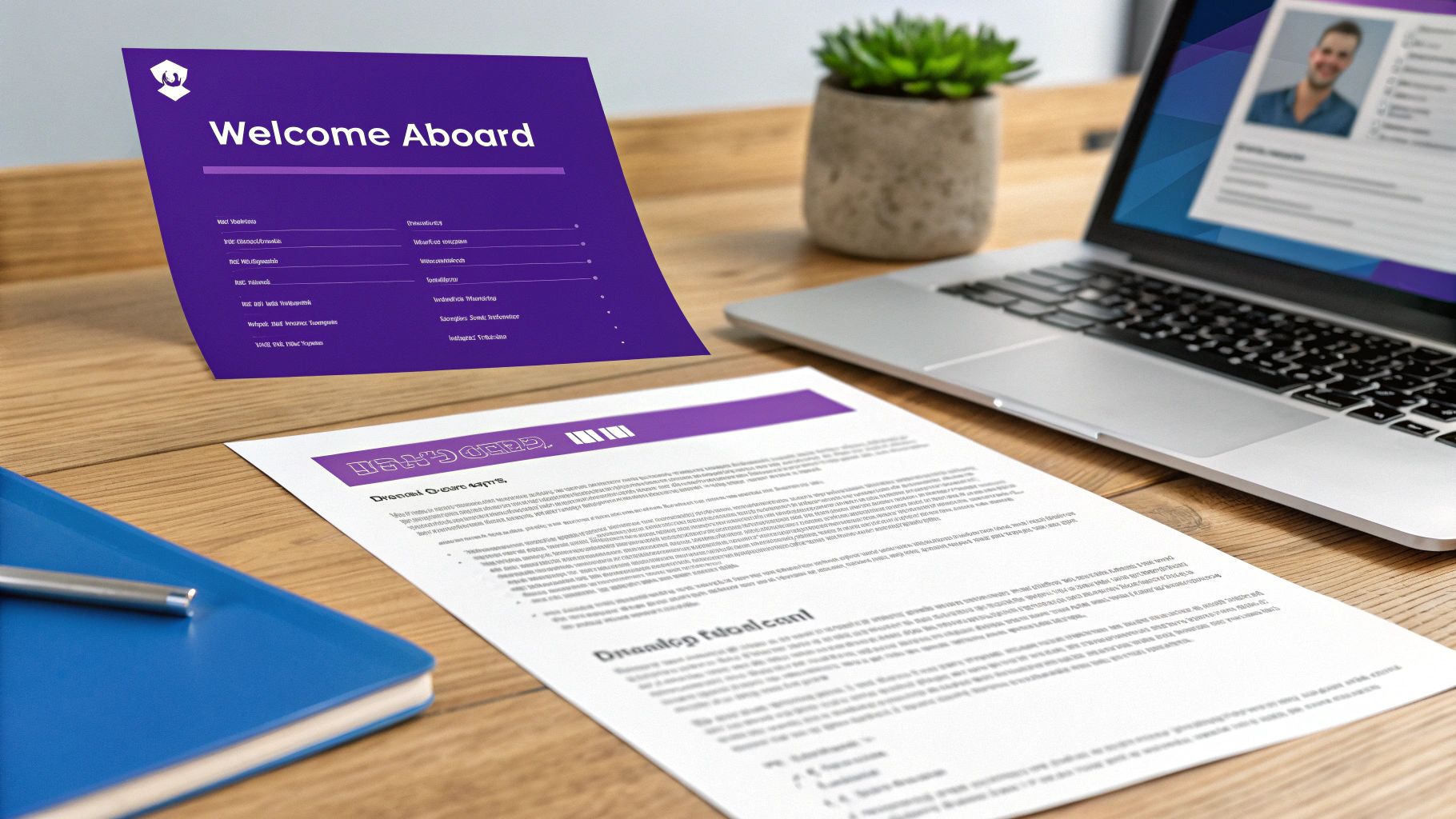
This practice involves providing candidates with flexible options, accommodating different time zones, and reducing manual coordination. Leading tech companies like Stripe and HubSpot excel here by integrating self-scheduling tools directly into their process. This allows candidates to select a time that works for them from a pre-approved list, eliminating delays and empowering them to manage their own schedules. This simple change transforms a potential point of friction into a positive, seamless interaction.
How to Implement Flexible Scheduling
- Implement Self-Service Scheduling Tools: Integrate tools like Calendly or the built-in scheduling features of modern ATS platforms like Greenhouse and Lever. This allows candidates to book their own interview slots.
- Offer Multiple Time Slots: When sending a scheduling link or manual options, provide at least three to four varied time slots across different days and times to accommodate different schedules.
- Respect Time Zones: For remote or non-local candidates, always clarify time zones and present interview options in their local time to avoid confusion.
- Send Automated Reminders: Set up automated email or text reminders to be sent 24 hours and one hour before the interview. This reduces no-shows and helps the candidate feel prepared.
5. Constructive Feedback and Transparent Rejection
A truly exceptional candidate journey doesn't end when a "yes" is given; it extends to how you handle rejection. One of the most mature candidate experience best practices is providing constructive, transparent, and empathetic feedback to candidates you don't hire. Ghosting applicants or sending a generic, cold rejection email erodes brand trust and leaves a lasting negative impression on a candidate who could be a future customer, partner, or employee.
Treating rejection as an opportunity to support a candidate's professional development transforms a negative outcome into a positive brand interaction. Companies like Netflix are known for their direct and honest feedback, while Google has experimented with sending rejected candidates links to learning resources based on their interview performance. This approach shows you value the individual's effort and respects them as a professional, fostering goodwill and strengthening your employer brand in the long term.
How to Implement Constructive Rejection
- Never Ghost a Candidate: Ensure every single applicant, regardless of the stage they reached, receives a clear notification about the outcome. Even a polite, automated rejection for initial applications is better than silence.
- Focus on “Fit” vs. “Flaw”: Frame feedback around the specific needs of the role and team alignment, rather than pointing out a candidate's deficiencies. For example, "We decided to move forward with a candidate whose experience was more closely aligned with the B2B SaaS focus of this particular role."
- Offer Actionable Insights: For candidates who invested significant time in later interview stages, offer a brief, scheduled call to provide specific, constructive feedback. Highlight their strengths and suggest areas for growth.
- Keep the Door Open: If a candidate was a strong contender, let them know. Invite them to connect on LinkedIn and express interest in considering them for future opportunities that may be a better fit. You can learn more about how candidates can turn this into a positive by dealing with job rejection.
6. Professional and Respectful Interview Conduct
A cornerstone of candidate experience best practices is ensuring that every interviewer acts professionally, consistently, and respectfully. The interview is often the most direct and personal interaction a candidate has with your company, making it a critical moment of truth for your employer brand. This practice involves using structured interviews, training interviewers on objective evaluation, and creating a fair process for all applicants.
When interviews are disorganized, biased, or disrespectful, candidates feel devalued and are likely to share their negative experiences publicly. Conversely, a professional and well-structured process signals that your company values fairness, competence, and people. Companies like Amazon demonstrate this by anchoring interviews around their Leadership Principles, while Salesforce requires mandatory unconscious bias training for all hiring managers. This commitment to structure ensures every candidate is evaluated on the same merit-based criteria.
How to Implement Professional Interview Conduct
- Standardize Interview Questions: Develop a core set of behavioral and skills-based questions for each role to ensure every candidate is assessed against the same benchmarks.
- Train Your Interviewers: Require all employees involved in hiring to complete training on structured interviewing techniques, unconscious bias, and illegal questioning. This equips them to be effective brand ambassadors.
- Use Evaluation Rubrics: Create a scoring rubric with a defined scale (e.g., 1-5) for key competencies. This moves evaluations from "gut feelings" to data-driven decisions and helps interviewers prepare for a job interview with a clear framework.
- Assemble Diverse Panels: Implement diverse interview panels that include members from different departments, backgrounds, and seniority levels to mitigate individual bias and provide candidates with a broader perspective of your company culture.
7. Comprehensive Employer Branding and Transparent Job Information
Another critical component of candidate experience best practices is building an authentic employer brand and providing completely transparent job information. This goes beyond a simple job description to offer a genuine window into your company’s culture, values, team dynamics, and day-to-day realities. When candidates have a clear picture of what it’s truly like to work for you, they can self-select, leading to better-aligned applicants and higher retention rates.
Misaligned expectations are a major source of post-hire dissatisfaction. By being upfront about not just the perks but also the challenges of a role, you build trust from the very first interaction. Companies like Netflix, with its detailed culture and values deck, and Zappos, with its famous culture book, exemplify this by setting realistic expectations. This honesty ensures that the candidates who proceed are genuinely enthusiastic about the opportunity as it truly exists, not just an idealized version.
How to Implement Comprehensive Employer Branding
- Be Radically Honest in Job Descriptions: Instead of just listing responsibilities, include "a day in the life" scenarios. Be explicit about potential challenges, such as high-pressure deadlines or the need to build processes from scratch.
- Showcase, Don't Just Tell: Create video testimonials featuring current employees from various departments and seniority levels. Share authentic stories about their experiences, growth, and even the obstacles they've overcome.
- Publish Your Culture and Values: Document and share your company’s core values, operating principles, and cultural norms. HubSpot’s comprehensive Culture Code is a prime example of putting this into practice.
- Provide Salary and Benefits Transparency: Clearly state the salary range and provide detailed information about benefits on the job posting. This respects a candidate's time and ensures compensation alignment from the start.
8. Efficient Assessment and Testing Practices
One of the most delicate yet crucial candidate experience best practices is the use of assessments that are relevant, fair, and respectful of a candidate's time. Efficient testing practices involve using validated tools that accurately predict job performance without creating unnecessary friction or anxiety. Poorly designed or excessively long assessments can feel like a chore, causing top candidates to drop out and share their negative experiences.
When assessments directly correlate to the job's core functions, they become a valuable, two-way evaluation tool. Candidates gain a realistic preview of the work, while employers gather objective data on capabilities. Companies like Google use targeted coding challenges for engineering roles, while platforms like Pymetrics use AI-driven games to assess behavioral traits. This approach demonstrates a commitment to hiring based on skill and potential, which enhances the perception of fairness and professionalism.
How to Implement Efficient Assessments
- Align Tests with Job Duties: Ensure every assessment directly measures a skill critical to the role. A marketing candidate shouldn't be solving complex algebra, but a data analyst should be tested on their SQL proficiency.
- Set Clear Expectations: Before the assessment begins, clearly communicate the purpose, format, time limit, and what is being evaluated. Provide practice questions to reduce anxiety.
- Respect Candidate Time: Keep assessments concise and focused, ideally between 30 and 90 minutes. For more complex evaluations, consider offering take-home projects with flexible deadlines.
- Share Results and Feedback: Follow up with candidates to discuss their assessment results, especially for those moving forward. This transparency builds trust and provides a valuable learning experience, reinforcing a positive candidate journey.
9. Quick Onboarding and Integration After Offer Acceptance
The candidate experience doesn't end when an offer is accepted; it extends into the critical pre-boarding and onboarding phases. One of the most forward-thinking candidate experience best practices is ensuring a seamless and swift transition from candidate to employee. This period between acceptance and the first day is when new hire enthusiasm can either flourish or fade. A well-structured integration plan demonstrates organizational efficiency and reinforces the new hire's decision to join your company.
When the post-offer process is slow or silent, new hires can experience "buyer's remorse," making them susceptible to counteroffers. A proactive onboarding strategy keeps them engaged and excited. Companies like Google excel here with comprehensive pre-boarding programs that include welcome packages and early access to internal resources. Similarly, Shopify's remote onboarding ensures new team members feel connected and prepared from anywhere in the world, maintaining momentum from the final interview through their first critical weeks.
How to Implement Quick Onboarding and Integration
- Send Offer Documents Immediately: Follow up a verbal offer with the official written offer letter and required paperwork within a few hours to formalize the commitment.
- Provide a Pre-boarding Checklist: Create a clear timeline of what the new hire can expect before their start date, including paperwork deadlines, equipment shipment, and key contacts.
- Facilitate Early Connections: Have the hiring manager send a welcome email within 24 hours of acceptance. Introduce them to a designated "buddy" or mentor before their first day to foster an immediate sense of belonging.
- Prepare Their First Week: Schedule essential first-week meetings, team introductions, and initial training sessions in advance. Share the agenda with the new hire so they know exactly what to expect.
10. Candidate Relationship Management (CRM) and Follow-up
An often-overlooked yet powerful candidate experience best practice is building and nurturing a long-term talent pipeline through effective Candidate Relationship Management (CRM). This strategy involves treating promising candidates who weren't selected for a current role as valuable connections for the future. Instead of a transactional "no thanks," this approach transforms the interaction into an ongoing professional relationship, keeping your company top-of-mind for future opportunities.
When you invest in maintaining these connections, you create a warm pool of pre-vetted talent, significantly reducing future time-to-hire. Companies like Apple and HubSpot are known for this, using sophisticated CRM tactics to re-engage strong past applicants with relevant new roles. This proactive nurturing shows candidates you value their skills beyond a single job opening and respects the effort they invested in your process, turning a rejection into a positive, long-term brand touchpoint.
How to Implement Candidate Relationship Management
- Segment Your Talent Pool: Use your Applicant Tracking System (ATS) or a dedicated CRM to tag and segment past candidates by skill set, role interest, and interview stage. This allows for targeted, relevant outreach.
- Create Nurture Campaigns: Develop automated but personalized email campaigns to share company news, industry insights, or culture-related content. This keeps your brand visible without being overly promotional.
- Connect on a Professional Level: Encourage recruiters to connect with high-potential candidates on LinkedIn within a week of the final decision. This maintains a direct and professional line of communication.
- Share Relevant Opportunities: When a new role opens up that matches a past candidate's profile, reach out personally. A simple message like, "Hi [Name], I hope you're well. A new [Job Title] role just opened up that I thought you’d be a great fit for," is highly effective. You can find more tips for organizing your pipeline in this job application tracking template.
10-Point Candidate Experience Best Practices Comparison
| Practice | 🔄 Implementation Complexity | ⚡ Resource Requirements | 📊 Expected Outcomes | 💡 Ideal Use Cases | ⭐ Key Advantages |
|---|---|---|---|---|---|
| Clear and Transparent Communication | Medium — process + templates | Medium — comms staff/tools | Higher candidate satisfaction; lower time-to-hire | High-volume hiring; employer-brand focus | Builds trust; reduces uncertainty |
| Streamlined Application Process | Low–Medium — UX changes | Medium — platform/dev effort | Higher completion rates; larger applicant pool | Campus hiring; mass recruitment; mobile-first roles | Increases applications; reduces drop-off |
| Personalized Candidate Experience | High — data + workflows | High — personalization tech & time | Higher engagement; higher offer acceptance | Senior/competitive roles; talent markets | Improves fit; stronger employer brand |
| Timely Interview Scheduling & Flexibility | Low–Medium — tooling + policy | Medium — scheduling integrations | Fewer no-shows; shorter scheduling cycles | Distributed/global hiring; time-sensitive roles | Reduces admin; improves attendance |
| Constructive Feedback & Transparent Rejection | Medium — process + training | Medium — recruiter time | Preserves reputation; encourages reapplication | Brand-conscious companies; talent retention | Maintains relationships; supports growth |
| Professional & Respectful Interview Conduct | Medium–High — training + coordination | Medium — training resources | Fairer evaluations; improved hire quality | Roles needing consistent assessment | Reduces bias; improves decision accuracy |
| Comprehensive Employer Branding & Job Info | High — content + maintenance | High — marketing & content teams | Better cultural fit; improved retention | Competitive talent markets; employer differentiation | Attracts right-fit candidates; reduces churn |
| Efficient Assessment & Testing Practices | Medium–High — test design & validation | High — assessment platforms/tools | More predictive hires; objective decisions | Technical roles; competency-based hiring | Provides objective data; reduces bad hires |
| Quick Onboarding & Integration After Offer | Medium — cross-functional coordination | Medium–High — HR/IT resources | Faster time-to-productivity; higher early retention | Roles with immediate ramp-up needs | Keeps momentum; smooth integration |
| Candidate Relationship Management (CRM) & Follow-up | High — ongoing strategy & systems | High — CRM platforms + content | Talent pipeline growth; reduced future time-to-hire | Continuous hiring; hard-to-fill roles | Builds long-term talent pool; lowers costs |
Transform Your Hiring from a Process to an Experience
Navigating the journey from initial job posting to final onboarding is a complex dance of logistics, communication, and human connection. As we've explored, elevating this journey from a mere administrative process to a memorable, positive experience is no longer a "nice-to-have" but a critical business imperative. The ten pillars we've detailed, from transparent communication and streamlined applications to respectful feedback and efficient onboarding, are not isolated tactics. They are interconnected components of a holistic strategy that defines your employer brand in the eyes of every applicant.
Implementing these candidate experience best practices is a commitment to building relationships, not just filling roles. It's about recognizing the humanity in every resume and the courage it takes to pursue a new opportunity. A disjointed, impersonal, or slow process doesn't just deter top talent; it actively damages your reputation, leading to a weaker talent pipeline, higher acquisition costs, and diminished employee morale before a new hire even starts.
From Insights to Action: Your Next Steps
The path to a world-class candidate journey begins with a single, deliberate step. Avoid the paralysis of trying to overhaul everything at once. Instead, adopt an incremental approach focused on high-impact areas.
- Audit Your Current Process: Use the ten best practices in this article as a scorecard. Where are you excelling, and where are the most significant gaps? Solicit honest feedback from recent hires and candidates who were not selected.
- Prioritize One or Two Key Initiatives: Perhaps the most common complaint is a lack of communication. Make a commitment to acknowledging every application within 48 hours. Or maybe your application process is too cumbersome; set a goal to reduce the completion time by 30%.
- Empower Your Hiring Team: Equip your managers and recruiters with the training and tools needed to conduct structured, respectful interviews and provide meaningful, constructive feedback. Consistency is key to delivering a unified brand experience.
Ultimately, mastering the candidate experience is about embedding respect, transparency, and empathy into the DNA of your recruitment culture. It's an investment that pays compound interest. Each positive interaction strengthens your employer brand, creating a virtuous cycle where top talent seeks you out. You're not just hiring an employee; you are building a community of advocates who will champion your organization, whether they receive a job offer or not. This is the strategic advantage that will define the most successful companies in the years to come.
As a job seeker, managing applications and tracking your progress is crucial to navigating the hiring landscape effectively. Take control of your own candidate experience with Eztrackr, a powerful tool designed to help you organize job applications, manage contacts, and stay on top of every interview stage. Visit Eztrackr to streamline your job search and turn a stressful process into a structured path to your next great opportunity.
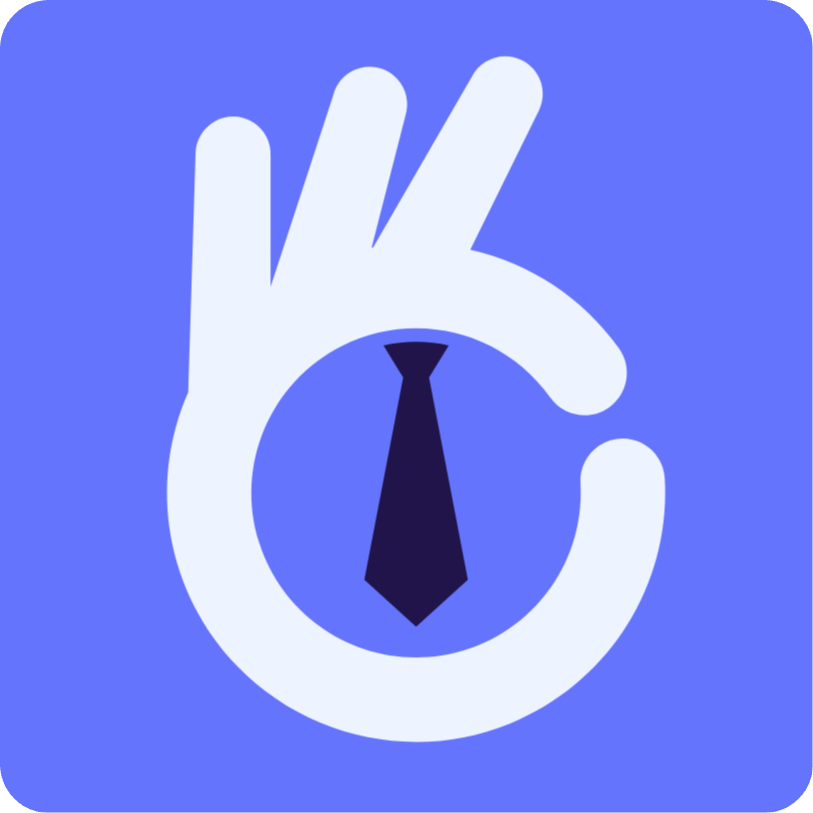 Interview Sidekick
Interview Sidekick